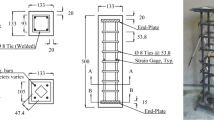Abstract
This paper deals with the effect of structural size of reinforced concrete columns with square cross sections on their nominal strength and post-peak behavior. This topic was studied experimentally on three different sizes of geometrically similar specimens. Our attention was focused on the overall performance of columns, in particular: peak strength, post-peak branch, type of a failure, concrete softening and steel buckling. Computational model based on the microplane model M4 for concrete [1,2] was used to simulate experimental results. As the result of experiments, no significant size effect was found in the nominal strength. However, size effect was found in the post-peak behavior. Results of the computer simulation showed good agreement with experimental data and proved the capabilities of the used material model.
Résumé
L'effet de la taille structurale des colonnes en béton armé avec une section carrée sur leur résistance nominale et le comportement après-pic est étudié dans l'article. Cet effet a été étudié à l'aide d'une expérience sur trois échantillons de tailles différentes mais de géométrie ressemblante. L'attention est concentrée sur le comportement global des colonnes et en particulier sur la résistance en pic, la partie de la courbe après-pic, le type de rupture, le ramollissement du béton et le flambement de l'acier. Le modèle numérique basé sur le modèle microplane M4 pour le béton [1, 2] a été utilisé pour la modélisation de l'expérience. Les résultats expérimentaux ont montré qu'aucun effet significatif de l'échelle de taille sur la résistance nominale n'a été trouvé. Cependant, il existe un effet de l'échelle sur le comportement après-pic. Les résultats numériques sont en bon accord avec les données expérimentales et l'utilisation du modèle a été justifiée.
Similar content being viewed by others
References
Bažant, Z.P., Carol, I., Adley, M.D. and Akers, S.A., ‘Microplane model M4 for concrete, I.: Formulation with work-conjugate deviatoric stress’,Journal of Engineering Mechanics 126 (9) (2000) 944–953
Caner, F.C. and Bažant, Z.P., ‘Microplane model M4 for concrete, II.: Algorithm and calibration’,Journal of Engineering Mechanics 126 (9) (2000) 954–961.
Bažant, Z.P., Xiang, Y. and Prat, P.C., ‘Microplane model for concrete, I.: Stress-strain boundaries and finite strain’,Journal of Engineering Mechanics (1996).
Bažant, Z.P., Xiang, Y., Adley, M.D., Prat, P.C. and Akers, S.A., ‘Microplane model for concrete, II.: Data delocalization and verification’,Journal of Engineering Mechanics (1996).
Bažant, Z.P. and Planas, J., ‘Fracture and size effect in concrete and other quasibrittle materials’ (CRC Press LLC, Boca Raton, Florida, 1998).
Bažant, Z.P. and Kwon, Y.W., ‘Failure of slender and stocky reinforced concrete columns: test of size effect’,Mater. Struct. 27 (1994) 79–90.
Brocca, M. and Bažant, Z.P., ‘Size effect in concrete columns. Finite-element analysis with microplane model’,Journal of Struct. Mech. 127 (12) (2001) 1382–1390.
Bittnar, Z., Kruis, J., Nêmeček, J., Patzák, B. and Rypl, D., ‘Using Heterogeneous Clusters of PCs for Parallel Computing’, (Proceedings of 5th International Conference on Computational Structures Technology, Leuven, Belgium, Civil-Comp Press, 2000).
Carpinteri, A., ‘Scaling laws and renormalization groups for strength and toughness of disordered materials’,Int. Journal Solids and Structures (1994).
Hollingworth, S.C., ‘Structural and mechanical properties of high strength concrete’, Ph.D. thesis, University of Wales, Cardiff, 1998.
Němeček, J., ‘Modeling of compressive softening of concrete’, Ph.D. thesis, CTU reports, Prague, 2000.
Němeček, J., Patzák, B., Rypl, D. and Bittnar, Z., ‘Microplane models: computational aspects and proposed parallel algorithm’,Computers and Structures 80 (2002) 2099–2108.
Ouyang, C. and Shah, S.P., ‘Fracture energy approach for predicting cracking of reinforced concrete tensile members’,Structural Journal ACI 91 (1994) 69–78.
http://ksm.fsv.cvut.cz/oofem/, ‘Finite element software OOFEM, Dept. of structural mechanics, CTU Prague’.
Patzák, B., ‘Object oriented finite element modeling’,Acta Polytechnica, Prague, (1999).
Patzák, B., ‘Material models for concrete’, Ph.D. thesis (in Czech), CTU Prague, 1997.
Řeřicha, P., ‘Optimum load history for non-linear analysis using dynamic relaxation’,Journal of Structural Mechanics (1986).
van Mier, J.G.M., ‘Strain-softening of concrete under multiaxial loading conditions’, Ph.D. thesis, Eindhoven University of Technpology, The Netherlands, 1984.
Vonk, R., ‘Softening of concrete loaded in compression’, Ph.D. thesis, Eindhoven University of Technology, 1992.
Author information
Authors and Affiliations
Additional information
Editorial Note Prof. Zdeněk Bittnar is a RILEM Senior Member.
Rights and permissions
About this article
Cite this article
Němeček, J., Bittnar, Z. Experimental investigation and numerical simulation of post-peak behavior and size effect of reinforced concrete columns. Mat. Struct. 37, 161–169 (2004). https://doi.org/10.1007/BF02481615
Received:
Accepted:
Issue Date:
DOI: https://doi.org/10.1007/BF02481615




